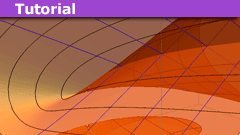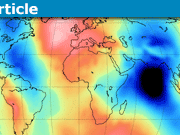Intro to Centrifugal Force Reversal in Kerr Spacetime
In this article, we will analyze “centrifugal force reversal” in Kerr spacetime, similar to what was done for Schwarzschild spacetime in a previous Insights article. As our starting point, we will use the formulas for the frame field, proper acceleration, and vorticity of an observer in a circular orbit in the equatorial plane of Kerr spacetime that we derived in our study of Fermi-Walker transport. These formulas are:
$$
\hat{p}_0 = \frac{1}{D} \partial_t + \frac{\omega}{D} \partial_\phi = \gamma \hat{h}_0 + \gamma v \hat{h}_3
$$
$$
\hat{p}_1 = \partial_z
$$
$$
\hat{p}_2 = W \partial_r
$$
$$
\hat{p}_3 = \frac{\omega r H^2 – B}{W D} \partial_t + \frac{V^2 + \omega r B}{r W D} \partial_\phi = \gamma v \hat{h}_0 + \gamma \hat{h}_3
$$
$$
A = \frac{W}{D^2} \left[ \frac{M}{r^2} \left( 1 – a \omega \right)^2 – \omega^2 r \right]
$$
$$
\Omega = \frac{1}{D^2} \omega \left[ 1 – \frac{3M}{r} \left( 1 – a \omega \right) \right] + \frac{M a}{r^3 D^2} \left( 1 – a \omega \right)^2
$$
where we have defined the following convenience functions:
$$
B = \frac{2 M a}{r^2}
$$
$$
V^2 = \left( 1 – \frac{2M}{r} \right) = \left( 1 – \frac{B r}{a} \right)
$$
$$
H^2 = \left[ 1 + \frac{a^2}{r^2} \left( 1 + \frac{2M}{r} \right) \right]
$$
$$
W^2 = 1 – \frac{2M}{r} + \frac{a^2}{r^2} = V^2 + \frac{a^2}{r^2} = V^2 H^2 + B^2
$$
$$
D^2 = V^2 + 2 \omega r B – \omega^2 r^2 H^2
$$
We also have the following formulas for the velocity ##v## of the rotating observer relative to a static observer, and the associated ##\gamma## factor ##1 / \sqrt{1 – v^2}##:
$$
\gamma = \frac{V^2 + \omega r B}{V D}
$$
$$
\gamma v = \frac{\omega r W}{V D}
$$
$$
v = \frac{\omega r W}{V^2 + \omega r B}
$$
First, we will look at the factor ##\left( 1 – a \omega \right)## which appears in the formula. We want to know if this factor can ever vanish or change sign. There will be a maximum value of ##\omega## (as a function of ##r##), because the orbiting observer cannot travel faster than light relative to a static observer, i.e., we must have ##v < 1##. This leads to the following condition on ##a \omega##:
$$
a \omega < \frac{a V^2}{r \left( W – B \right)}
$$
This leads to:
$$
a \omega < \frac{r – 2 M}{r \sqrt{1 + \frac{r \left( r – 2M \right)}{a^2}} – 2 M}
$$
It is evident that this gives ##a \omega < 1## for all ##r > 2M##. It might seem like there is an issue at ##r = 2M##, since the formula seems to force ##\omega = 0##. However, for ##r = 2M##, and any smaller ##r##, there are no static observers, so all of our formulas involving ##v## and ##\gamma## become invalid in that regime.
This creates a problem if we want to be able to extend our analysis into the region ##r < 2M##. And we do want to do that, because this region, called the “ergosphere”, has some interesting properties that we want to explore. So we need to find another way of looking at things.
It turns out that the key observation we need is that, in Kerr spacetime, zero angular velocity and zero angular momentum are not the same. This concept appears in most treatments of Kerr spacetime, and we will not try to derive it from scratch. Instead, we will take advantage of the fact that the answer is already known to ask the question: what do our formulas say for the case of an observer with the following angular velocity?
$$
\tilde{\omega} = \frac{B}{r H^2} = \frac{2 M a}{r^3 H^2}
$$
We could, by the way, get at this ansatz in a way that isn’t quite the same as the usual way, by looking for a maximum of ##D## as a function of ##\omega##. Since ##D## is positive we can just as well look for a maximum in ##D^2##, by taking its derivative with respect to ##\omega##:
$$
\frac{d}{d \omega} D^2 = 2 r B – 2 \omega r^2 H^2
$$
Setting this to zero gives ##\omega = \tilde{\omega}##, and taking the second derivative and finding it negative shows that this is a maximum. In other words, the observer at a given altitude with the fastest clock rate, relative to infinity, is not the hovering observer (with ##\omega = 0##), but the ZAMO (with ##\omega = \tilde{\omega}##). So it seems worthwhile to look at the behavior of the proper acceleration and vorticity relative to the ZAMO angular velocity, instead of relative to zero angular velocity.
As an additional observation, we note that ##\left( 1 – a \tilde{\omega} \right)## is positive for all ##r## outside the horizon for ##a < M## (which is the only case we’re considering). This is easily computed using ##r_+ = M + \sqrt{M^2 – a^2}## (the computation is helped by noting that ##r_+^2 + a^2 = M^2 + 2 M \sqrt{M^2 – a^2} + M^2 – a^2 + a^2 = 2 M r_+## and thus ##r_+^3 H^2(r_+) = r_+ \left( r_+^2 + a^2 + 2 M a^2 / r_+ \right) = 2 M \left( r_+^2 + a^2 \right) = 4 M^2 r_+##):
$$
a \tilde{\omega} (r_+) = \frac{a^2}{2 M^2 r_+}
$$
This is obviously less than 1 since ##a < M## and ##a < r_+## (in fact it will be less than ##1/2## for that reason). So the factor ##\left( 1 – a \omega \right)## is always positive for a ZAMO. And we know that, in the region ##r \le 2M##, which is the region our analysis above, based on the velocity ##v## relative to a static observer, couldn’t cover, the angular velocity of any timelike orbit must get closer and closer to ##\tilde{\omega}## as ##r## gets closer to the horizon. So we expect that the factor ##\left( 1 – a \tilde{\omega} \right)## will be positive outside the horizon for any timelike orbit.
If we plug this value into the formulas for the frame field vectors, we find (using ##\hat{w}## for this particular frame field):
$$
\hat{w}_0 = \frac{H}{W} \partial_t + \frac{B}{r H W} \partial_\phi
$$
$$
\hat{w}_3 = \frac{1}{r H} \partial_\phi
$$
where we have used the fact that for ##\omega = \tilde{\omega}##, we have ##D = W / H##. We see immediately that this frame field has the nice property that ##\hat{w}_3## is a unit vector purely in the ##\phi## direction (which is what we expect for the frame field of a zero angular momentum observer). What we want to do now is to rewrite the general congruence ##\hat{p}## in terms of ##\hat{w}##, and find expressions for the relative velocity ##\tilde{v}## and corresponding relativistic factor ##\tilde{\gamma}## of a general rotating observer relative to a ZAMO. This works out as follows:
$$
\hat{p}_0 = \tilde{\gamma} \hat{w}_0 + \tilde{\gamma} \tilde{v} \hat{w}_3
$$
$$
\hat{p}_3 = \tilde{\gamma} \tilde{v} \hat{w}_0 + \tilde{\gamma} \hat{w}_3
$$
$$
\tilde{\gamma} = \frac{W}{H D}
$$
$$
\tilde{\gamma} \tilde{v} = \frac{\left(\omega – \tilde{\omega} \right) r H}{D}
$$
$$
\tilde{v} = \frac{\left(\omega – \tilde{\omega} \right) r H^2}{W}
$$
Then we can re-write the formulas for proper acceleration and vorticity as follows:
$$
A = \frac{\tilde{\gamma}^2 H^2}{W} \left[ \frac{M}{r^2} \left( 1 + a^2 \omega^2 \right) – \omega^2 \left( 1 + H^2 \right) r \right]
$$
$$
\Omega = \frac{\tilde{\gamma}^2 H^2}{W^2} \omega \left[ 1 – \frac{3M}{r} \left( 1 – a \omega \right) \right] + \frac{\tilde{\gamma}^2 H^4 \tilde{\omega}}{2 W^2} \left( 1 – a \omega \right)^2
$$
- Completed Educational Background: MIT Master’s
- Favorite Area of Science: Relativity










Leave a Reply
Want to join the discussion?Feel free to contribute!